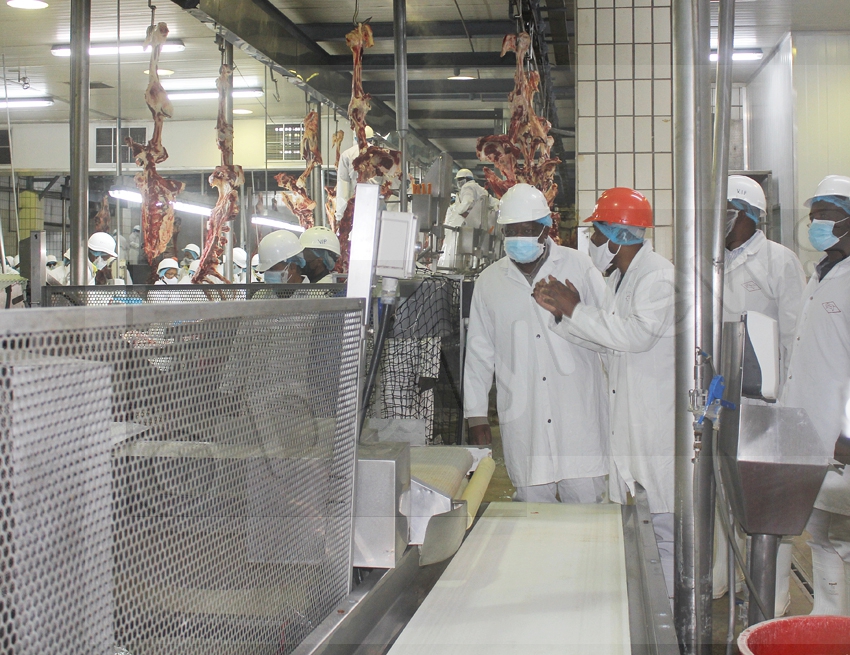Manufacturing sector shows growth since 1994
21 Feb 2022
Parliament has learnt that over the period of 1994 to 2020, the manufacturing sector grew in real terms by 4 per cent a year on average compared to 3.5 per cent a year for Gross Domestic Product as a whole.
Briefing Parliament on behalf of the Minister of Investment, Trade and Industry, the Minister of Finance and Economic Development, Ms Peggy Serame said according to Statistics Botswana and the World Bank reports, the contribution of the manufacturing sector to Gross Domestic Product (GDP) was 4.4 per cent in 1980, 4.9 per cent in 1990, 7.5 per cent in 2000, 8.5 per cent in 2010 and 5.7 per cent in 2020.
The most recent data series published by Statistics Botswana, Ms Serame said indicated that the average contribution of the manufacturing sector to the GDP for the period 1994 to 2020 was 7.3 per cent.
She said even though the Ministry did not set targets in the earlier years for the contribution of the manufacturing sector to GDP, in 2019 the Ministry set a yearly target of 7 per cent for the period 2019 to 2036.
Minister Serame also said government had undertaken steps to bolster growth of the manufacturing sector, including the prioritised value chain development to unlock opportunities to promote citizen economic empowerment.
Ms Serame said the initial sectors of focus included minerals, tourism, food and education. “This also include funding of enterprises in the prioritised sectors,” she said.
Furthermore, she cited the development of Special Economic Zones such as the Pandamatenga which focuses on agricultural production including agro-processing, imposition of import restrictions of commodities such as bottled water, school uniform which had resulted in increased production of such products within the country.
Minister Serame said government would also bolster the manufacturing sector through the Botswana Investment and Trade Centre attracting FDI into export oriented manufacturing.
In addition, Ms Serame highlighted that in rural areas the Local Economic Development programme was being implemented by the Ministry of Local Government and Rural Development specifically targeting the growth of industries in the rural areas. Minister Serame said in terms of performance, the manufacturing sector had helped to reduce the import bill.
“In 2020, the imported manufactured goods totaled P41 billion, while domestic production of manufactured items was just under P10 billion,” she said.
Ms Serame said the manufacturing sector reduced the import bill as many domestically produced goods would otherwise would have been imported.
“According to Statistics Botswana, formal employment sector statistics, the ratio for manufacturing sector employment to that of formal sector was 6.7 per cent in 1980, 8.7 per cent in 1990, 11.2 per cent in 2000 and 10.2 percent in 2010,” said Minister Serame. She said in 2020, the new quarterly multi topic on household survey showed that manufacturing accounted for 7.7 per cent of formal employment.
She said the survey uses a different methodology to the old formal employment survey and hence the results were not directly comparable. Nevertheless, Ms Serame said the result showed that the manufacturing sector was relatively labour intensive and accounted for a large share of employment than of GDP.
“The Industrial Development Policy of 2014 broadly defines industrialisation to include manufacturing and services, while in proportional terms the contribution of the manufacturing sector to GDP has remained constant over time. In absolute terms the manufacturing sector has been growing,” said Ms Serame.
The Member of Parliament for Bobonong, Mr Taolo Lucas had asked the Minister of Investment, Trade and Industry to state the contribution of the manufacturing sector to Gross Domestic Product (GDP) in the years 1980, 1990, 2000, 2010 and 2020.
Mr Lucas also wanted to know the targeted contribution of the sector to the economy in each year. In addition, Mr Lucas asked how the performance of the manufacturing sector had been affected in relation to the country’s import bill, levels of employment and levels of industrialisation.
The minister was also required to state specific and new steps being undertaken to bolster the growth of the manufacturing sector in general and specifically in rural areas. ENDS
Source : BOPA
Author : Moshe Galeragwe
Location : Parliament
Event : Virtual Parliament
Date : 21 Feb 2022



